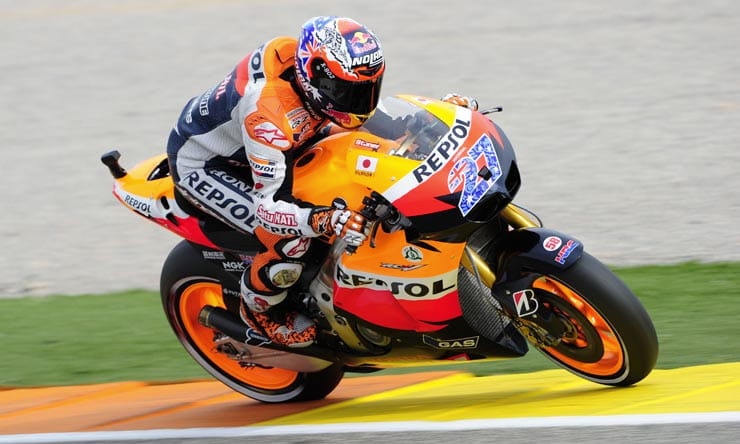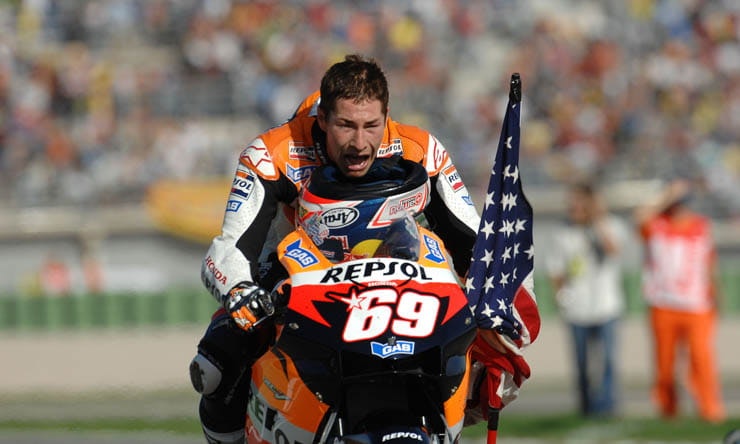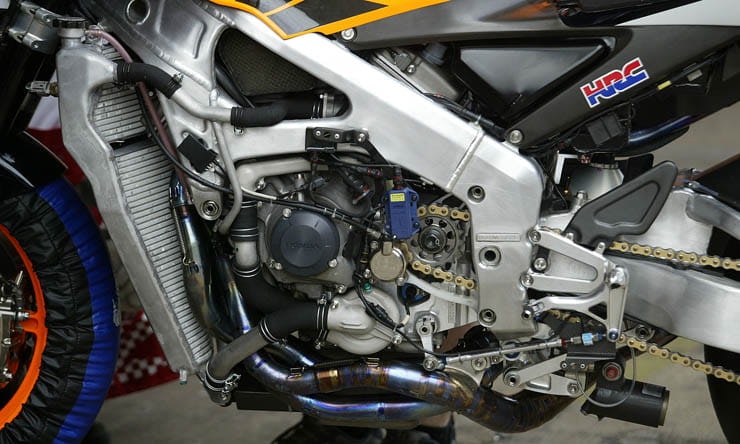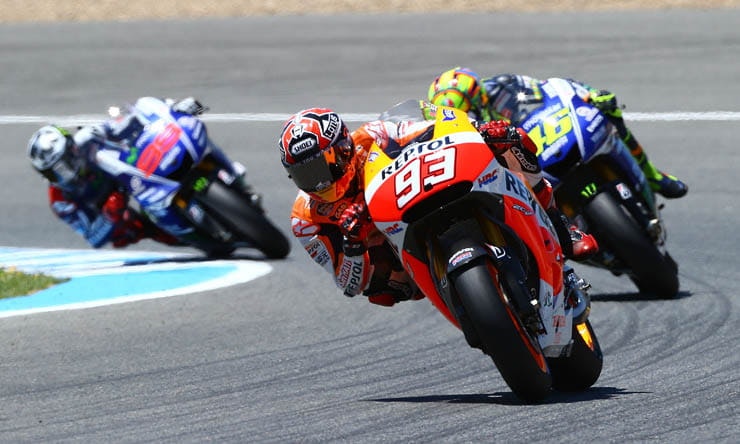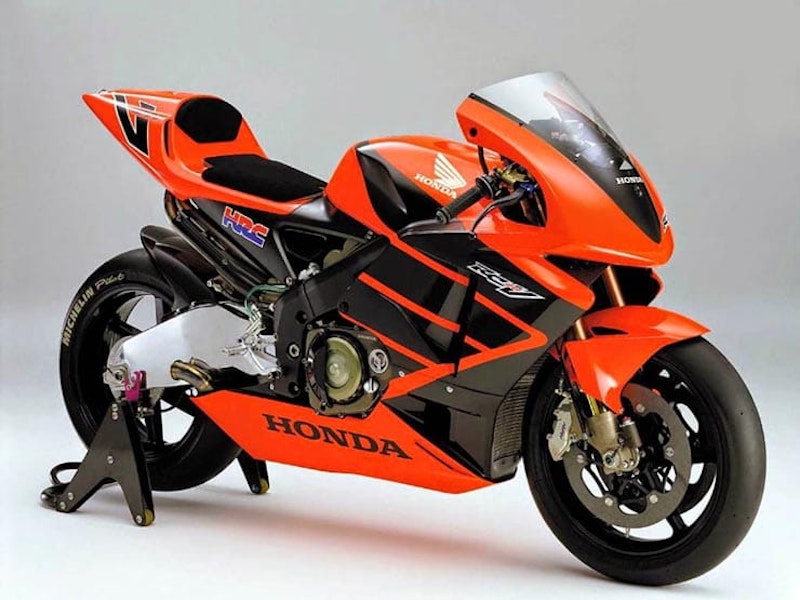Fifteen years ago we saw the biggest regulations shake-up ever witnessed in the top class of motorcycle racing. The introduction of the four-stroke MotoGP class, in one sweep, killed the two-stroke as a top-class racer and doubled the maximum permitted engine capacity.
The result was a class of monstrous machines that lives on today, albeit following much rule-tweaking. Massive power and torque unlike anything seen before in world championship road racing led to fearsome bikes that have made legends of the men who’ve tamed them.
Look back to the turn of the millennium and grand prix bike racing was in rut. The 500cc two-strokes might be evocative machines but they were irrelevant to the manufacturers that the series wanted to attract. Why invest a fortune in developing two-stroke technology, they wondered, when it was inherently unsuited to meeting the ever-more-demanding emissions limits that regulated road-going bikes? As marketing tools, the strokers didn’t reflect the competitors’ showroom machines and a lack of investment meant that the bikes weren’t evolving much from one year to the next.
Meanwhile, four-stroke superbike racing had flourished through the 1990s. Its road-based bikes looked familiar and inspired fanatical loyalty among fans, while charismatic riders in tooth-and-nail battles made it essential viewing. Grand Prix racing was under threat, struggling to attract both crowds and manufacturer involvement.
The solution was a technological upheaval. The creation of an open set of regulations that came into force in the transitory 2002 season, when satellite and private teams on strokers competed against the new four strokes, and took over completely in 2003.
All change for 2002
An unusual 990cc capacity limit for four-stroke engines was the headline shift. That seemingly arbitrary figure was picked to help ensure manufacturers didn’t simply pluck existing 1000cc (usually actually 998 or 999cc) engines from road bikes, and to help settle fears among world superbike bosses that the two championships would tread on each other’s toes.
The thinking was straightforward. In a two-stroke engine, each cylinder has a power stroke once per engine revolution. In a four-stroke it only happens once every two revolutions. So, in simple terms and at similar revs, a 500cc two-stroke will make as much power as a 1000cc four-stroke. MotoGP didn’t want to go backwards in terms of power, so rule makers aimed for as close to 1000cc as they could manage.
As well as the 990cc capacity limit, the rules specified that the engines had to be prototypes. You couldn’t just de-stroke a production motor to meet the capacity limit. One early competitor, the plucky WCM team that created its own four-stroke to compete against the factory efforts, fell foul of this when stewards decided its engine was too similar to that of a production Yamaha R1.
What the 2002 rule makers didn’t bank on was the level of expertise in making high-revving, high-performance four-strokes. While the rules were intended to favour the four-strokes, few expected them to be as powerful as they proved to be. Where the last of the 500s were reckoned to make around 180-200bhp, the 2002 four-strokes were immediately well over the 200bhp mark and development quickly pushed them higher still.
Within the new regulations were subtleties that initially led to widely differing concepts from one manufacturer to the next. Most importantly, the 990cc class hung onto the idea of offering different minimum weights depending on the number of cylinders used.
That’s because engines with more, smaller cylinders can generally rev higher than ones with fewer, larger pistons. More revs equals more power. Back in the 1960s, Honda proved to be the experts at this, creating machines like the famous 250cc six-cylinder and 125cc five-cylinder race bikes. Later, in the late '70s and early '80s, Honda’s NR500 – the last four-stroke GP racer before the 2002 class – tried to overcome rules limiting them to four cylinders by using oval pistons and eight valves per cylinder. It was basically a V8 with pistons merged into pairs, and while it still didn’t prove competitive against two-strokes, the design nearly matched them in terms of power.
The new rules for 2002, as a direct result of the NR500, specifically catered for oval pistons. Clearly believing Honda would revive the idea, the initial regulations added a 10kg weight penalty for oval-pistoned engines with less than six cylinders.
Two or three-cylinder bikes were allowed to be 135kg (145kg with oval pistons). Four or five cylinder machines had to be 10kg heavier at 145kg (155kg with oval pistons) while bikes using six cylinders – the maximum allowed under the 2002 regs – had to be 155kg (no additional penalty for oval pistons). This was an extension of previous GP regulations that limited four-cylinder strokers to 130kg and allowed twins like the Honda NSR500V and Aprilia’s 250-derived RSW to come in at a flyweight 105kg.
Surprisingly, manufacturers were fairly evenly split over their decisions in terms of cylinder count. Triples, fours and five-cylinders all raced in that first year, while both twin-cylinder and six-cylinder projects were also started, even if they never reached the track. In the run-up to the start of the series, speculation on the decisions that each firm would make ran rife.
Over the next few days we’ll be reintroducing you to every generation of each major MotoGP bike to have raced in the 15 years since MotoGP’s 2002 transformation and demonstrating how those bikes evolved into the masterpieces that will be battling for glory in 2017. Today we start by looking at the lineage of Honda's mighty RCV racer.
Gestation of the RC211V
In the run-up to 2002, everyone’s attention was focussed on Honda. The undisputed masters of GP racing, Honda already had key elements in place to be the dominating force in the new series.
Not only did the firm have the most recent experience of racing a four-stroke at GP level – the NR500 in the early 1980s – but it was also alone in having current F1 car technology at its disposal, having provided power to the BAR team (which it would later buy) since 2000. There was also the trifling matter of a young Italian chap by the name of Rossi who’d spectacularly sewn-up the last-ever two-stroke title on the firm’s old NSR500.
In the run-up to the RC211V’s reveal in early 2001 – nearly a year before it would race – Honda worked on a variety of engines. It ruled out twins and sixes – the former would be too weak, the latter’s power and heavier weight would destroy tyres too fast – but examined every other configuration before settling on a V5. It announced the bike’s layout in January 2001.
That layout surprised everyone. While many suspected that four-cylinder engine or inline triples would be the way to go in MotoGP, or possibly even V6s, the 75.5 degree V5 seemed an odd configuration.
While the layout, with three cylinders in the front bank and two in the rear, clearly throws up balance problems to be overcome, particularly at the stratospheric revs of a GP bike, Honda’s logic made sense. With five cylinders it could be nearly as powerful as a V6 while still using the same 145kg minimum weight limit as its more obvious four-cylinder rivals.
2002 RC211V
The first glimpse of the RC211V came in April 2001, when spy shots of the bike testing at Sugo emerged. Those first pictures immediately established the style that the bike would retain throughout its race career, although it initially lacked the curled under-seat exhaust for the rear cylinder bank, instead using a very road-bike-style single end can on the side.
A more official reveal of the bike came at the Suzuka 8-hour race in August 2001, where Mick Doohan gave it a public demonstration.
Once racing started in 2002, the 2002 RC211V instantly showed its dominance. Combined with Rossi it proved a nearly unbeatable combination. Rossi won 11 races, coming second in four others. He never finished lower than that.
In the races that Rossi didn’t win, the RC211V was still nearly unbeatable. His Repsol Honda team-mate Tohru Ukawa took one win, while Alex Barros – who started the year on the old two-stroke NSR in the West Honda squad before getting a four-stroke mid-season – took two victories including an inspirational win on his first four-stroke ride.
Only twice was the Honda beaten; Biaggi’s Yamaha M1 took victory at Brno – the only race all year in which Rossi retired, thanks to tyre problem – and again in Malaysia, riding out of his skin to pip four Hondas to the post. He was a full 23 seconds ahead of the next non-Honda.
Does that record make the 2002 RC211V the most impressive MotoGP bike in history? It’s got to be a contender.
2003 RC211V
If the 2002 RCV was a sea-change compared to the previous NSR500, it was its evolution into the 2003 version that established the look that Honda would stick to throughout its development.
The big visual changes were the new nose intakes, neatly incorporated triangular openings that would later be mimicked by the 2004-on Fireblade. The seat unit was also cleaned up, with larger air intakes instead of the vertical slots of the first-generation.
Technically, the bike’s configuration wasn’t changed but it gained a couple of vital improvements. One was a slipper clutch – yes, the first generation had done without a piece of kit that even fairly average road-going sports bikes get these days – while the other was a rudimentary traction control system.
Power was up, to a conservatively-estimated 230bhp, so those aids were no doubt welcome.
If rivals had hoped that they’d catch up with Honda, the 2003 RC211V was to leave them disappointed. While Rossi didn’t dominate quite as completely as in 2002 (he ‘only’ won nine races on his way to the 2003 title), Sete Gibernau’s move from Suzuki to Honda set the pair up for a series of famous battles. Biaggi, Yamaha’s only winner in 2002, also moved to Honda. Eventually, the RC211V won 15 of the year’s 16 races, split between those three riders. The one that got away? It went to Capirossi on the new Ducati Desmosedici at Catalunya, just six races into its career.
2004 RC211V
Visual changes between the 2003 and 2004 RC211Vs are few and far between, although each body panel was refined for the bike’s third year of competition. The seat unit was again updated, as was the nose, but the real changes were under the skin.
There were wholesale updates to the rear suspension, with a repositioned shock, while the engine gained another thing that’s since become standard fare in production bikes; an electronic, fly-by-wire throttle. This allowed the previous year’s rudimentary traction control, which had been based around cutting fuel injection and altering ignition timing, to include throttle movements.
Compared to today’s gyro-based TC systems, it was still incredibly basic, using front and rear wheel speeds as its inputs, but it did allow anti-wheelie to be incorporated for the first time.
On track, the 2004 bike’s seven wins, split between Gibernau, Biaggi and Tamada, couldn’t make up for Rossi’s miraculous first season on the Yamaha, having split from Honda at the end of 2003.
Yamaha hadn’t won at all the previous year, but Rossi achieved nine victories on the M1 in 2004 (every race not won by Honda), including his first race on the bike. Other Yamaha riders barely saw the podium, making 2004 the year that cemented Rossi’s position as the GOAT.
It also put an end to chances of the much-rumoured road-going RC211V. Honda bosses are thought to have green-lit a limited-production V5 superbike (rather like the more recent RC213V-S) on the proviso that the RC211V should win both the riders and constructors titles for three years running. The 2004 bike just missed that target, and the road-going version was canned.
2005 RC211V
Once again, visible changes on the 2005 RC211V are hard to spot, with the firm concentrating on improving the engine’s delivery and tweaking the chassis to make it easier to ride.
However, with its roots still firmly planted in the original 2002 bike’s design perhaps the '05 version was getting a bit long in the tooth, because it never came close to matching its forebears in terms of performance.
Yamaha – or rather Rossi – dominated the season with 11 victories. Even with only two wins, Movistar Honda’s Marco Melandri took second in the championship, with Nicky Hayden clinching third place and a single victory on the factory Repsol machine.
Honda needed to change something if it was to bounce back. For 2006, it would.
2006 RC211V
By the start of 2006, MotoGP had long since fixed the fact that the following year, 2007, would see a wholesale shake-up of the rules, with capacities dropping to 800cc to slow bikes down.
For many, that made 2006 a holding year. Why invest heavily in the old 990cc bikes when there was a new 800 to develop? Honda, of course, did the opposite, and made the biggest changes that the RC211V would see in its career.
Dubbed the ‘new generation’ RC211V, the 2006 bike ridden by team leader Hayden was a stepping stone towards the 800cc future. New packaging allowed a shorter frame and a longer swingarm, while the aerodynamics started to reflect Honda’s new thinking, which was to minimise the side bodywork.
Engine-wise, the fly-by-wire system was revised. For 2006, the rear two cylinders’s throttles were completely computer-operated, while Hayden had direct control over the front three. It combined instant response with a power curve that could be carefully tailored.
The changes took the RC211V back to the top of the pack, with Hayden taking the rider’s title, Honda the manufacturer’s championship – albeit after a tough fight that saw five riders winning races across three manufacturers during the season. Hayden only had two wins but consistency brought him the title (Rossi had five wins and Capirossi – on the Ducati – had three, as did Honda-mounted Melandri.)
2007 RC212V
A change of rules, a change of capacity and a change in cylinder count for 2007 meant that the new bike deserved a new name. For the dawn of the unloved 800cc MotoGP era, Honda created the RC212V.
It was a step change from the previous bike. Not only was the oddball five-cylinder layout replaced by Honda’s return to its favoured V4 configuration, but the RC212V was visibly smaller than its predecessor. Skimpy bodywork reflected new aerodynamic thinking and was aimed at improving the bike’s handling rather than chasing out-and-out top speeds. Relatively little bodywork area, particularly when seen from the side, was intended to help the bike’s characteristics in yaw. Even the under-seat exhaust got the boot – Honda was focussed on mass-centralisation and didn’t want its weight hanging so far from the centre of gravity.
The stubby, upswept tail doesn’t look so strange now – we’ve become more used to road bike styling with short tails – but back in 2007 it was an unusual look.
Typically, Honda saw rules intended to reduce power outputs as a challenge. Even with one cylinder and nearly 200cc lopped off, the RCV still made more than 220bhp in 2007.
Promising on paper, the 2007 RC212V’s performance was disappointing. Pedrosa managed to scrape second in the championship but was light years from the performance of Casey Stoner on the 800cc Ducati, who dominated the year. The Honda was too hard to ride, perhaps a result of focussing too much on outright power, while the decision to step away from straight-line aero superiority was in direct contrast to the Desmosedici, which used all-enveloping bodywork that couldn’t have been more different to the skimpy Honda style.
2008 RC212V
Recognising the 2007 bike as a misstep, Honda went back to the drawing board for the 2008 model.
With mass-centralisation taking a back seat, the 2008 bike looks larger and regained the under-seat exhaust for the rear cylinder bank. Overall, the look is a step back towards the more successful RC211V’s style, albeit with a new, softer nose shape that’s starting to look a bit like today’s Honda race bikes.
From a tech standpoint, the big news was the introduction of pneumatic valves. Honda wasn’t the first with this tech – Aprilia went there years earlier with its evil RS Cube – but it promised to once again boost power. The frame was completely new and the rear suspension design changed to swap to an under-braced swingarm design.
It might have been a big change for the bike, but the results were no better. Honda had another miserable year as Yamaha-riding Rossi regained the title with a dominant performance. Pedrosa scraped two wins for Honda, but that was all the firm had that year.
2009 RC212V
While the 2008 bike’s results weren’t what Honda wanted, it didn’t opt for an out-and-out redesign again for 2009. In fact, the '09 bike is visually very similar to its predecessor.
Perhaps unsurprisingly, the results weren’t much better either. Although Honda dedicated itself to a monument improvement programme for the bike during the year, the works pairing of the loyal Dani Pedrosa and Andrea Dovizioso struggled for results early in the season.
Eventually, the firm even went so far as to move away from its long-standing suspension partner Showa in favour of Ohlins. Dovi’s bike ran the Swedish kit for the second half of the season while Pedrosa’s stuck with Showa.
Two wins for Pedrosa brought him third in the championship, while Dovizioso’s lone victory, at Donington Park, could only scrape sixth in the final standings. The 800cc era continued to mark a low point for Honda in MotoGP.
2010 RC212V
Despite its lacklustre results in 2009, Honda retained faith with the general design of the RC212V for 2010.
In appearance terms, the most notable change was a continuation of the move away from the 2007 RCV’s skimpy bodywork philosophy towards a more all-enveloping style. The side panels now completely covered the engine and much of the frame, for instance, and the previously tiny seat unit had swollen back to RC211V-style dimensions. A massively-braced swingarm hinted at changes to the bike’s structural rigidity.
For 2010, the ties with Showa were also cut; the factory Hondas went to Ohlins kit.
And in results terms, the evolutionary approach started to pay off. While the championship was a Lorenzo walkover – he ended more than 120 points clear of the next best – Pedrosa took second place once again. His four wins were the only ones Honda could claim in 2010, but were encouraging after a bleak couple of years. They also helped tempt Casey Stoner away from Ducati for the following year.
2011 RC212V
As Honda entered 2011 – the last year of the 800cc regulations before the switch to more powerful 1000cc bikes in 2012 – it faced the real possibility that it would leave the 800cc era without winning a title. For a firm in Honda’s position, that wasn’t acceptable.
Fortunately, it had a couple of aces up its sleeve for 2011. While the bike was, essentially, the same as the 2010’s, with no stunning visual changes, there was something notably different on top of it; Casey Stoner.
The second secret weapon was harder to spot. Under the familiar V4 engine lay Honda’s new seamless transmission, which allowed full-power gear shifts without an interruption in power delivery. It was so secret that only one technician was allowed to work on it, away not only from rivals’ eyes but also hidden from other members of his own team. Each gearbox was said to cost as much as a house but the payoff was a noticeable improvement in lap times.
The two-pronged approach was unbeatable and led to Honda domination of the sort not seen since Rossi left. Stoner took ten wins and never finished off the podium, Pedrosa another three, and Honda romped away with both the rider’s and manufacturer’s titles.
The RC212V’s triumphant final season was, though, marred by the death of Honda’s prodigy, Marco Simoncelli, in Malaysia.
2012 RC213V
With 2012 came another big regulation shake-up. Intended to cut costs and inject more thrills into the racing, the switch to a 1000cc capacity limit and rules allowing road-bike-derived machines to take part led to redesigns all through the field.
As the third generation of 21st-century four-stroke Honda, the new bike was named RC213V.
Internally, of course, it was new. The V4 engine was upped to 1000cc, marking a shift towards the incredible power of today’s MotoGP machines. While nobody will confirm exact figures, numbers as high as 270bhp have been bandied about for the pneumatic-valved monsters.
This year also saw the introduction of the confusing ‘claiming rule’ and associated CRT machines. These lower-cost bikes used standardised electronics and could be production-bike-based, with concessions in the form of a higher fuel limit and laxer engine life rules to help encourage less wealthy entrants. Honda build a special customer bike, the RCV1000R, to suit. Looking just like an RC213V, it lacked the pneumatic valves and seamless shift.
The factory bike was hard to argue with – it won 12 of the year’s 18 races – but Jorge Lorenzo took the remaining six and, thanks to incredible consistency that meant he never finished lower than second, won the rider’s title for Yamaha. Honda took the manufacturers’ crown, though.
2013 RC213V
Honda was on a roll now, and even the early retirement of team leader Casey Stoner at the end of 2012 couldn’t stop the team’s success. Particularly since his replacement was Marc Marquez.
Once again, the bike’s changes were evolutionary. MotoGP had, by now, reached the point where frames, bodywork and even engine specs were being altered throughout the season, so the eagle-eyed might spot updates from one race to the next just as much as from one year to another.
On the 2013 bike, the bodywork tweaks were minimal – reshaped vents, tweaks to the seat and tank shape – and the existing philosophy in terms of chassis were retained.
Again, it was the bike to beat, delivering Marquez the title on his debut season.
2014 RC213V
With the focus increasingly on electronics rather than more visible evolutions in terms of chassis or aerodynamics, the 2014 RCV was again visually more of the same.
One notable change was the new, gaping nose intake, an evolution from the previous year that gave the bike a recognisably different face. But changes elsewhere were hard to spot.
In terms of result, the Honda was perfect from day one. Marquez achieved a remarkable 10 straight victories at the start of the season, with three more in the second half, to romp to the title. A resurgent Rossi on the Yamaha made the end of the season a generational battle, but couldn’t do anything to overcome the enormous lead of the Honda.
2015 RC213V
Was Honda sitting on its laurels in 2015? A quick glance at that year’s RC213V shows a machine so similar to the previous model that it might have been one and the same. Sure, some of the stickers were new, but technical revelations were hard to find.
On the privateer side, there was more to crow about. For 2015 the RCV1000R was replaced with the RC213V-RS customer bike. While the seamless shift gearbox was still exclusive to the works machines, at least these subsidiary teams now got pneumatic valves to help overcome the horrible performance deficit that the earlier bike had suffered.
And there was another variation, too. The road-going RC213V-S finally ended years of speculation as to whether Honda would build a road-going GP bike.
On track, even Marc Marquez couldn’t do enough to beat Yamaha in 2015. While Rossi and Lorenzo duked it out for the title, the Honda man trailed in a distant third.
2016 RC213V
New tyres and new electronics were the name of the game in 2016. With standardised traction control being applied across the board and new Michelin rubber replacing the Bridgestones that had been used since 2008, Honda didn’t make big changes elsewhere.
The firm concentrated on tuning the chassis stiffness to suit the new tyres – visual clues including details like a new swingarm, now with a large hole on the right hand side.
We also saw the Honda, like everything else in 2016, sprouting a variety of wings during the season, albeit not to the extent of some of its rivals.
Perhaps proving that steady evolution is the best route to success, the almost invisible changes were still enough to hoist the Honda back to the top of the pack in 2016, with Marquez taking his third title on the machine.
2017 RC213V
Will the latest bike be able to repeat its championship winning ways? The wings are gone but again the changes seen pre-season have been small.
There’s been no hint yet that Honda will adopt the sort of ‘hidden’ wings that other firms have experimented with in pre-season testing. Given that Honda never got as seriously involved with wings as its rivals – and still won the 2016 title anyway – perhaps it makes sense to do without them and concentrate on more traditional routes to performance.
The RCV’s effect on production bikes
During the early years of the dominant V5-powered RC211V endless rumours circulated that Honda was developing a road going version. The truth of the issue is likely to remain hidden, but Honda certainly patented sketches of an RC211V with headlights and a licence plate, suggesting there was more than just wishful thinking behind the stories.
In terms of real production bikes, the Fireblade was the obvious beneficiary of the RCV’s development. The 2004 Blade (above) gained RC211V-shaped bodywork, leaning on the aerodynamic lessons from MotoGP, while the 2008 model adopted the compact, mass-centralised thinking of the RC212V.
Finally, of course, the RC213V led to the MotoGP bike for the road that had been on so many wish-lists for over a decade. Quite simply a full-on GP bike with the bare minimum of changes as a nod to legality and practicality, it doesn’t feature the works machines’ pneumatic valves or seamless shift, but is seriously close to the customer-spec RCV1000R racers.
